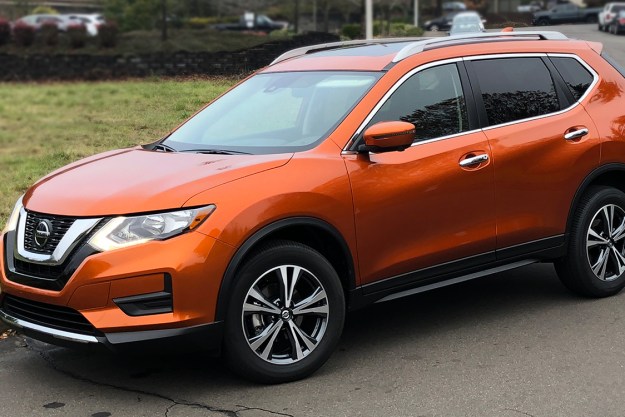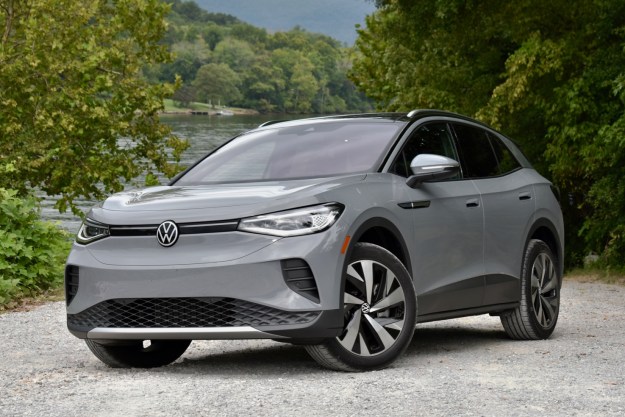
- Attractive pricing
- Decent performance
- Comfortable interior
- Usable cargo space
- Expensive premium audio option
- Low-mounted infotainment screen
Buyers love crossovers, and the competition for the top spot in the best-selling segment of the market is fierce. In most years, the Nissan Rogue comes out on top, but at the end of 2018, the Toyota RAV4 held the lead with 427,168 sales, followed by the Rogue at 412,110. In the first two months of 2019, the Rogue has surged back into the lead with 58,012 sales, far outpacing the 50,654 RAV4s sold. Honda’s CR-V landed in the middle with 55,456 sales.
This data may seem irrelevant to a review, but there’s a message in there: In this mission-critical market segment, Nissan is winning against the industry giants. The reasons for its success are simple: it’s a good product, and a good value for your money. The Rogue is a reasonably spacious five-passenger crossover SUV. It’s perfect for active singles, road trip-loving couples, or for growing families. Even if you choose the base trim and front-wheel drive at $25,965 (including all fees), the important features are included, like active safety plus smartphone integration. The Rogue can also tow up to 1,100 pounds, so a camper or boat trailer can be part of your life.
Nissan delivers the Rogue in three main trims: S, SV, and SL. Think of them as base, family, and luxury levels. The SV trim adds advanced safety tech like automatic reverse braking, plus family-friendly features like a motion-controlled liftgate, a remote engine starter with smart climate control, and heated front seats. The top SL trim is where you get it all, including Nissan’s ProPilot Assist steering system and adaptive cruise control, a surround-view camera, a more high-tech dashboard display, voice recognition, on-board navigation, and leather upholstery, just to name a few.

All Rogue trims are available in front- or all-wheel drive, and the SV and SL trims are offered with either a gasoline-powered engine or a gasoline-electric hybrid drivetrain. If you tick every box, the all-wheel-drive 2019 Nissan Rogue SL Hybrid will cost you $33,935, plus an extra $2,000 if you want the Bose stereo and the panoramic moonroof.
Interior and exterior design
The 2019 Rogue looks like a crossover SUV. There’s no attempt to make it look like a sports car or anything but what it is: a practical vehicle with off-pavement capabilities. As SUVs go, the Rogue is better looking than most, and Nissan has avoided the temptation to give it more coupe-like lines that don’t make it any prettier, but take away much-needed cargo capacity.
Inside, the Rogue is all business. Everything is where you expect to find it. The infotainment screen is near the top of the dashboard, but not floating above it, so it’s sometimes out of the driver’s line of sight. All trims get a 7.0-inch touchscreen system (which is smaller than the RAV4’s top-spec unit) that displays Nissan’s proprietary NissanConnect system. Not that many buyers will use it, because Android Auto and Apple CarPlay are both supported. Real climate control buttons are located just below the screen, which is nice. You don’t have to poke your way through a bunch of menus to adjust the temperature. It’s not fancy, even in the top trim, but it’s pleasantly functional.

As you sit in the Rogue, you notice the interior is well-made. Fit and finish are nicely executed, as you would expect from Nissan. If you buy the SV or SL trims, you get leather on the center console, the dashboard, and the steering wheel. The piano black trim around the center stack is a nice touch, giving the cabin a sense of understated quality not usually found at this price point.
As an SUV, the Rogue is all about cargo capacity. The Rogue provides 39.3 cubic feet behind the second row of seats, and up to 70 cubic feet when you fold everything down. The first figure is near the top of the class, but the CR-V offers 75.8 cubes with the rear seats folded flat. Hybrid buyers will need to give up cargo space for battery space, with 27.3 cubes behind the back seats, and 61.4 cubic feet with the rear seats folded.
Tech features
Nissan is leading the economy crossover class when it comes to available driver assistance technology. The firm calls it Intelligent Mobility, and the system comprises all the usual top-drawer features like adaptive cruise control, automatic emergency braking with pedestrian detection, and sonar-based rear automatic braking. Driver information tech features, including a 360-degree camera system, blind spot and rear cross traffic monitoring, and lane departure assistance are also included.
The jewel in Nissan’s driver assistance tech package is ProPilot Assist, which extends lane keeping capabilities into light self-steering.
The jewel in Nissan’s driver assistance tech package is ProPilot Assist, which extends lane keeping capabilities into light self-steering. ProPilot will keep the Rogue centered in its lane on long straights and around gentle curves. Other automakers also offer this level of assistance, but it’s generally limited to luxury brands like Nissan’s sister brand Infiniti, Mercedes-Benz, Cadillac, and of course Tesla. Toyota is just getting into Lane Tracing with the 2019 RAV4, while the Honda still offers the CR-V with lane keeping assistance.
This is where we have to put in the obligatory note that there are precisely zero self-driving cars available for public purchase today. ProPilot is not self-driving technology – it just keeps your car from wandering out of its lane if you’re not paying attention on easy roads. There are limits to how much steering it will do, and those limits are tighter than you think. The driver must keep both hands on the wheel and both eyes on the road at all times.
Driving impressions
The Rogue is powered by Nissan’s 2.5-liter, four-cylinder engine at all trim levels. This engine provides 170 horsepower and 175 pound-feet of torque, figures that make it less powerful than the RAV4’s four-cylinder. The engine is bolted to Nissan’s Xtronic continuously variable transmission (CVT), which makes good use of the available power to give the Rogue a solid driving experience. CVTs are a fact of life now in economy vehicles, and Nissan has the advantage of several years of development because they switched over early. The rubber band-like acceleration we’ve encountered in many cars equipped with a CVT is nowhere to be found in the Rogue.

ProPilot, and indeed all similar technology, can be unnerving. Especially if you’ve been driving for a few years, the feeling of the car automatically adjusting your steering is disconcerting. However, once you get used to the idea, ProPilot makes long stretches of freeway a little easier to manage. It keeps the Rogue centered in its lane, and its steering inputs are gentle, though it can be fooled by inconsistent lane markings, or when a lane gets wider in preparation for an off-ramp. Toyota’s lane tracing on the RAV4 and new Corolla are the same way.
It’s not a hot rod like the Infiniti crossovers, but the Rogue is a pleasant SUV to drive around town and on the highway.
The Rogue has a good suspension, and feels well-planted on the road, with a smooth, comfortable ride. Four-wheel disc brakes give it a short stopping distance, too. It’s not a hot rod like the Infiniti crossovers, but the Rogue is a pleasant SUV to drive around town and on the highway. Fuel economy is on par with the competition at 26 mpg in the city, and 33 mpg on the highway.
You can also get your Rogue with a hybrid drivetrain if you want to use a bit less gas. The Hybrid gets up to 33 mpg in the city, and 35 mpg on the highway with front-wheel-drive, or slightly less with AWD. You’ll get 176 total system horsepower and 144 pound-feet of torque from the gas engine. If that sounds disappointing, remember that hybrid torque and horsepower are measured at the wheels, so it’s actually got a little more scoot than the gas engine. One more thing: In the SL trim, the hybrid costs only $150 more than the gas engine, so it’s nearly free. There’s a $1,260 price delta in the SV trim.
Rivals
The two real rivals for the Rogue are the 2019 Toyota RAV4 and the 2019 Honda CR-V. The Honda retails for $25,395 at the FWD low end, and up to $35,195 at the AWD high end, while the Toyota sells for $26,595 in the base trim and up to $38,815 with AWD in the top trim with options. The RAV4 hybrid is a little bit more affordable, peaking at $36,900 with options. For reference, the 2019 Rogue ranges from $25,965 to $35,935.
Apart from Nissan’s leadership in driver assistance, these are all comparable SUVs in features and performance. Each has something the others don’t. Honda offers the LaneWatch system, which gives you a camera view of the right-hand blind spot when you activate the right turn signal. Toyota offers road sign assistance to keep you up to date on prevailing speed limits.
Peace of mind
The 2019 Nissan Rogue comes with a three-year, 36,000-mile basic warranty, extending to five years or 60,000 miles on the powertrain.
Basic safety equipment available on all trims includes all the usual government-mandated features, plus blind spot warning, intelligent lane intervention, automatic emergency braking with pedestrian detection, rear automatic braking, and rear cross-traffic alerts.
How DT would configure this car
With the comparatively short and inexpensive trim walk on the Rogue, there’s very little reason not to go big and get the advanced features. Further, with only a scant difference in price between the SL AWD and the SL Hybrid AWD, it makes no sense to sacrifice fuel economy for a lower purchase price. We recommend going all-in and getting the best that Nissan has to offer at $33,395. If you’re an audiophile, you can spend the additional $2,000 on the Bose stereo and panoramic moonroof on the Hybrid Premium package, but we wouldn’t.
Our Take
There are a bunch of good reasons why the Rogue is consistently one of the top three best-selling crossovers in America. Buyers get a nice SUV with decent performance and a great tech story at a price that’s equal or better than a comparable vehicle from the competition. The Rogue meets the needs of a compact crossover buyer, offers all-wheel-drive and a hybrid option, and looks very good for the money.
Should you get one?
Yes. The 2019 Nissan Rogue is popular because it offers a great value on a compact crossover. You can buy the features you need, and you don’t have to pay for those you don’t need.
Editors' Recommendations
- Mercedes-AMG EQE SUV first drive review: a better electric SUV
- Nissan wants the 2023 Ariya to be its comeback EV, but the bar has been raised
- 2022 Rivian R1S first drive review: An EV SUV fit for an expedition or a drag race
- Jeep Grand Cherokee 4xe first drive review: Do-it-all plug-in
- Nissan’s ‘smellmasters’ perform odor checks on new cars



